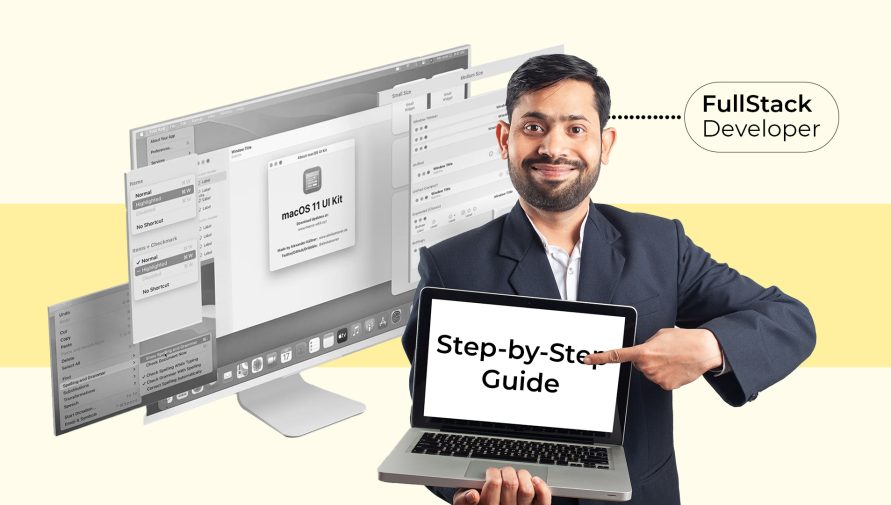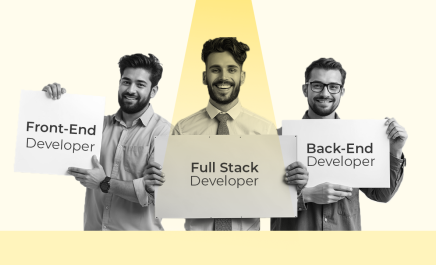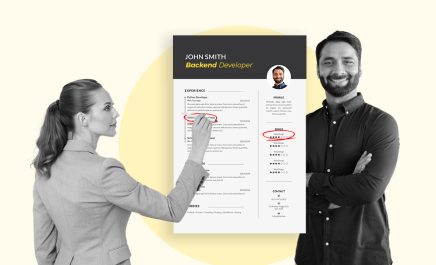Tips for Hiring Remote Full-Stack Developers: A Step-by-Step Guide
- Bhavik Suthar
- February 25, 2025
- 5 Minute Read

Employing remote full-stack developers presents a special chance to access global knowledge, create innovative apps, and experience unprecedented freedom.
However, finding the appropriate résumé isn’t enough to succeed at remote hiring; you must also locate the right fit for your team and objectives. Continue reading to learn how to handle the challenges of employing remote full-stack developers.
Understanding the Role of a Full-Stack Developer
A full-stack developer is a versatile software expert who develops everything from the user interface to server-side scripting and database design and ensures that all parts of an application seamlessly work together.
Here are the key responsibilities of a full-stack developer:
- Design and build user-friendly interfaces
- Create server-side architecture and effective APIs
- Design and maintain database systems
- Troubleshoot, debug and upgrade software
- Software testing for efficiency
- Coordination with stakeholders
Key Skills and Technologies
A full-stack developer should understand back-end and front-end technologies, version control systems, APIs, data structures, and algorithms well.
Here is a detailed breakdown of the technical skills for full-stack developers:
Front-End
Languages | Framework | Tools |
| HTML | React | Figma |
| CSS | Angular | Bootstrap |
| JavaScript | Vue.JS |
Back-End
Languages | Framework |
NodeJS | Django |
| Python | Spring Boot |
Java | Ruby on Rails |
Ruby | |
| PHP |
Databases
Knowledge of databases (MySQL, MongoDB)
Version Control
Collaboration and management tools like Git or GitHub
When hiring remote full-stack developers, ensure your candidate has these essential soft skills:
- Excellent communication skills
- Team Player
- Attention to detail
- Organizational skills
Benefits of Hiring Remote Full-Stack Developers

Here are the top advantages of hiring remote full-stack developers for your business:
Access to a Global Talent Pool
One of the main advantages of hiring remote full-stack developers is having access to a global talent pool. Without being constrained by regional resources, you can engage skilled developers from anywhere in the world.
In addition to increasing your options, this exposes your staff to new ideas and specialized knowledge that can improve your projects.
Cost Efficiency
Hiring remote developers can significantly reduce operational costs. You save on expenses related to office space, equipment, and other overhead typically associated with in-house teams.
Flexibility and Scalability
Remote teams are not just flexible; they’re extremely scalable as well, as they can easily mold themselves to the requirements of your projects. As far as remote developers are concerned, one has all the flexibility in increasing his staff or downsizing it as per the ever-changing needs.
Additionally, working with developers across different time zones enables you to keep moving around the clock, and flexible work patterns usually increase productivity.
Challenges in Hiring Remote Full-Stack Developers
Remote developer recruitment offers access to a vast talent pool yet has unique challenges.
Communication Barriers
Communication barriers might impact collaboration, decision-making, and progress.
- Cultural and linguistic differences could potentially result in miscommunication and misunderstandings.
- Time zone differences increase complexity in real-time collaboration and coordination.
Assessing Technical Skills Remotely
- Online coding tests may not fully reflect real-world problem-solving capabilities.
- Ascertaining the authenticity of the candidate’s portfolio is challenging.
Ensuring Cultural Fit
- Ensuring consistent productivity, accountability, and motivation in a remote environment is challenging.
- Integrating remote developers into existing teams and company culture requires deliberate strategies. This becomes difficult without direct interaction.
Step-by-Step Guide to Hiring Remote Full-Stack Developers

Let us outline the steps for hiring remote full-stack developers:
1. Define Your Project Requirements
Follow these steps to clearly define your project’s scope, objectives, and technical needs:
Project Scope
- Clearly state the project’s objectives and the expected deliverables.
- Include information about your target users and the problems your project addresses.
Technical Specifications
- Specify the exact technologies required for the job.
- Be clear with the front end, back end, security, and the expected traffic.
Budget and Timeline
- Fix a realistic budget including the development, maintenance, and hosting costs.
- Mention the project start and end date, including the deliverable deadlines.
2. Identify the Necessary Skills
In order to identify the necessary skills, make sure your job posting clearly outlines the technical and soft skills required. Also, make sure to demarcate the must-have and nice-to-have skills.
Technical Proficiency
- Proficiency in front-end, back-end, databases, and version control
- Experience in frameworks like React or Node.js might also be needed.
Soft Skills
- Clear communication and problem-solving skills are important.
3. Source Candidates
When hiring remote full-stack developers, casting a global net can help you discover top talent from around the world.
Start by exploring job platforms. General job boards like LinkedIn, specialized developer platforms, and remote job boards are excellent resources for finding candidates with the right skills and experience.
Additionally, leverage networking and referrals. Reaching out to trusted colleagues, industry peers, or professional networks can help you uncover highly qualified candidates who may not be actively searching but are open to new opportunities.
4. Screen and Evaluate Candidates
Technical skills assessments and behavioral interviews for problem-solving abilities and cultural fit should be part of a comprehensive candidate evaluation.
Technical Assessments
Use online examinations, coding challenges, or live coding sessions to assess candidates’ technical expertise and problem-solving skills.
Focus on relevant programming languages and technologies for front-end and back-end positions. Also, make sure to pay attention to their approach to problem-solving, code quality, and timeliness.
Interviews
Interview individuals to assess their communication abilities, work style, and experience. To evaluate their problem-solving and teamwork skills, pose behavioral questions. Make sure they can communicate and handle responsibilities in a remote setting, and that their work style and values complement the culture of your organization.
5. Onboard and Integrate
This step post-hiring is just as important to ensure a candidate’s success and onboarding into your team.
Clear Communication Channels
To ensure constant contact, set up clear channels of communication using programs like Zoom, Microsoft Teams, or Slack. In order to keep the remote team cohesive and engaged, establish standards for response times, preferred communication channels, and frequent check-ins.
Establish Expectations
Clearly define each team member’s roles, duties, and due dates. Establish project objectives and deadlines to help the team prioritize work and maintain transparency and alignment. Check in frequently to give feedback and evaluate progress.
To Wrap Up
Hiring remote full-stack developers can be a game changer for your business, opening doors to incredible talent, reducing costs, and giving your team the flexibility to thrive.
However, the process requires a thoughtful approach, from defining your project needs to assessing candidates and integrating them effectively into your team.
At Uplers, we provide access to a network of over 1.5 million pre-vetted talents, ready to start within 48 hours. Beyond simply helping you hire, we ensure seamless onboarding, fair pricing, and ongoing support throughout the project lifecycle. Contact us for more details!
Frequently Asked Questions
What are the key responsibilities of a full-stack developer?
Full-stack developer responsibilities involve managing user interface design, server-side scripting, and databases.
What technical skills should I look for when hiring a remote full-stack developer?
Technical skills for full-stack developers include proficiency in front-end and back-end technologies, frameworks, and database management systems.
How can I assess a remote full-stack developer’s skills effectively?
Technical tests, coding competitions, and structured interviews that emphasize problem-solving, familiarity with important technologies, and practical project experience are ways to evaluate the abilities of a remote full-stack developer.
What tools are essential for managing remote full-stack developers?
Remote full-stack developers can be managed using project management, version control, communication, and code collaboration tools.

Thank you for submitting the details!
We will keep your information safe. Feel free to contact us with any questions at hello@uplers.com
Please check your email for next steps shared by Robert.
















